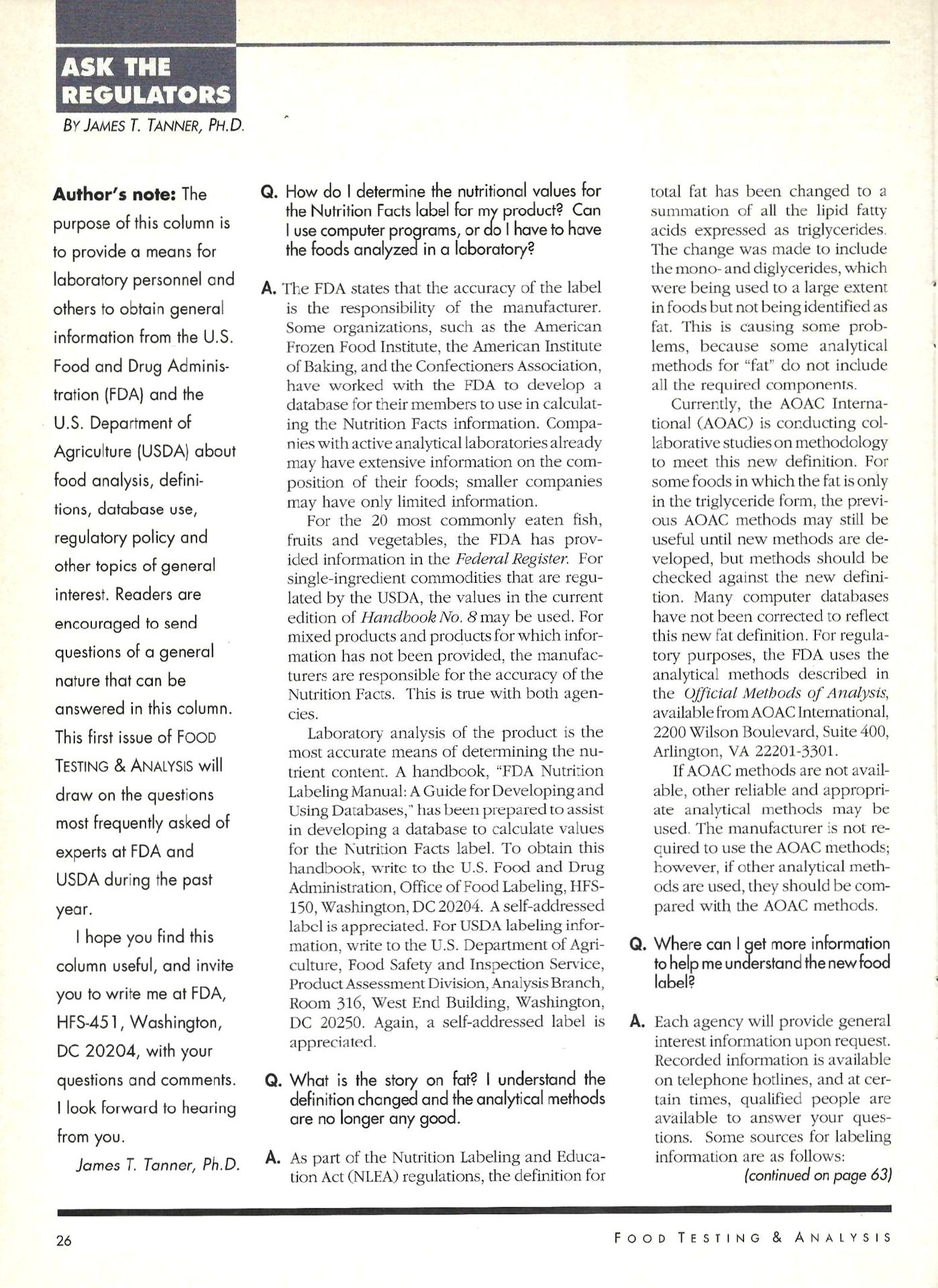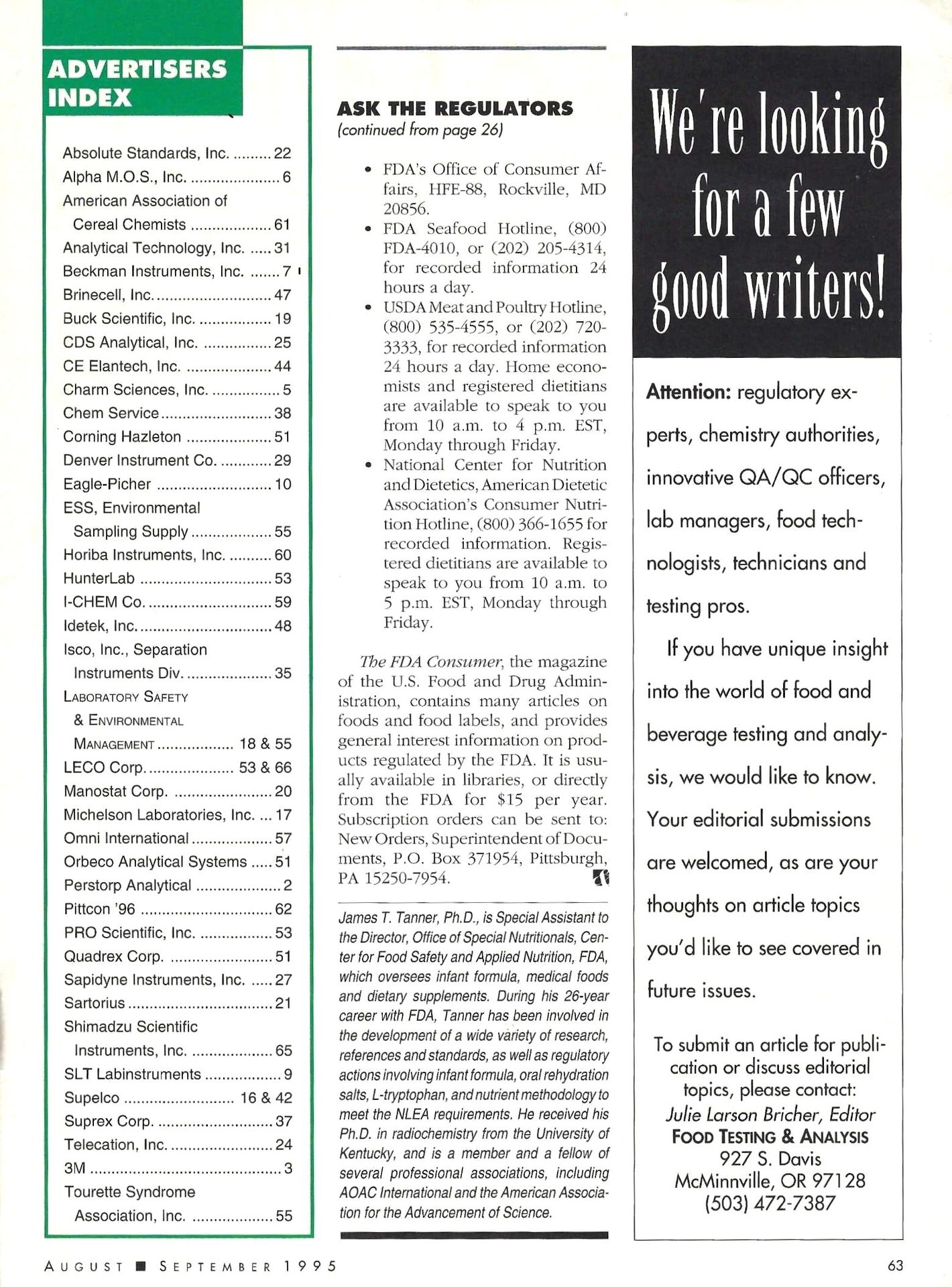30th Anniversary Retrospective

Celebrating 30 Years of Food Safety Solutions with FSM—And a Look Back at Nutrition Labeling
SCROLL
DOWN
If you've been watching this space over the past few issues, you know that I've been examining trends in food safety science and regulation from the present day versus the mid-1990s, when Food Safety Magazine debuted as Food Testing & Analysis.1,2,3 In this August/September issue of FSM, we commemorate the very first edition of Food Testing & Analysis, published in August 1995 (Figure 1).

FIGURE 1. The cover of the debut issue of Food Testing & Analysis, the precursor to Food Safety Magazine (Image credit: Food Safety Magazine)
Food Testing & Analysis was created to provide practical information to, and a professional forum for, laboratory personnel in the food and beverage testing and analytical industry. Food Safety Magazine has continued this tradition, expanding its target audience with the December 2000/January 2001 issue to include all food safety and quality professionals, across various roles and sectors.
The first issue of Food Testing & Analysis in August 1995 included a Q&A with Dr. James T. Tanner of the Food and Drug Administration (FDA) on a topic that is top of mind for today's FDA—nutrition labeling for packaged foods.
In his "Ask the Regulators" column (Figure 2), Dr. Tanner—then Special Assistant to the Director of FDA's Office of Special Nutritionals at the Center for Food Safety and Applied Nutrition (CFSAN)—shared guidance4 on how to determine nutritional values for the Nutrition Facts label for packaged food products. The Nutrition Facts label was established in 1994, mandated by the Nutrition Labeling and Education Act of 1990. The declaration of "trans fats" was included as a requirement in 2006, and FDA made significant revisions to the Nutrition Facts label in 2016, including updates to serving sizes, calories, and daily values for nutrients; the requirement of a declaration of added sugars; and voluntary listing for Vitamins A and C.
Dr. Tanner recommended laboratory analysis of food products as "the most accurate means of determining the nutrient content," and guided readers to FDA's Nutrition Labeling Manual: A Guide for Developing and Using Databases. This manual can now be viewed and downloaded online in its 2013 revised version5 rather than obtained solely by requesting a physical copy from FDA.


FIGURE 2. "Ask the Regulators" column from Food Testing & Analysis, August/September 1995 issue (Image credit: Food Safety Magazine)
In recent food labeling regulation news, FDA issued an update6 in June of this year to its General Food Labeling Requirements Compliance Program. The Compliance Program helps inspectors ensure that labeling of food products is truthful, not misleading, and compliant with federal regulations. The updates include key changes such as the addition of sesame as a major allergen, guidance on gluten-free labeling requirements, and formatting and nutrient declaration requirements outlined in the 2016 changes to the Nutrition Facts label. FDA also issued a final rule7 in December 2024 that updated the "healthy" claim for food labeling, 30 years after the nutrient claim "healthy" was first issued.
Another major labeling change on the horizon is the proposed "Front-of-Package" (FOP) nutrition label, which would require food manufacturers to include a condensed "Nutrition Info" label on the front of food packages.8 According to FDA, "Displaying simplified, at-a-glance, nutrition information that details and interprets the saturated fat, sodium, and added sugar content of a food as 'Low,' 'Med[ium],' or 'High' on the front of food packages would provide consumers with an accessible description of the numerical information found in the Nutrition Facts label."9 Manufacturers would also be allowed to voluntarily disclose calories on the front of food packaging. The public comment period for the proposed rule10 on FOP nutrition labeling was extended by 60 days to July 15; more information on the proposed rule is anticipated to be released after that time.
FOP labeling is already in use in a number of countries around the world.11 With the "Make American Healthy Again" (MAHA) Commission's focus on nutrition as a pillar of its Human Foods Program, it's no surprise that nutrition labeling is front-and-center again for FDA and the U.S. food industry. Health and Human Services Secretary Robert Kennedy Jr.'s crusade against "ultra-processed foods"—a core component of the MAHA Report12 that links childhood chronic disease to diet—provides more impetus for FOP labeling in the U.S. The report notes, "Most American children's diets are dominated by ultra-processed foods (UPFs) high in added sugars, chemical additives, and saturated fats, while lacking sufficient intakes of fruits and vegetables. This modern diet has been linked to a range of chronic diseases, including obesity, type 2 diabetes, cardiovascular disease, and certain cancers."13 If FOP nutrition labeling becomes law, then manufacturers will be required to visually highlight the saturated fat, sodium, and added sugar contents of their packaged food products.
We'll continue to keep you updated on FDA changes to labeling requirements so you can remain compliant with regulations. In the meantime, Dr. James Tanner's guidance to readers in 1995 remains sound advice: "The FDA states that the accuracy of the label is the responsibility of the manufacturer… [and] the manufacturers are responsible for the accuracy of the Nutrition Facts."4
“Big data and AI technologies, such as machine learning, show promise for informing AMR surveillance and mitigation efforts.”


Regards,
Adrienne Blume, M.A.
Editorial Director

References
- Blume, A. "Celebrating 30 Years of Food Safety Magazine—and a Look Back at Food Safety Then vs. Now." Food Safety Magazine February/March 2025. https://digitaledition.food-safety.com/february-march-2025/department-editors-letter/.
- Blume, A. "A Look Ahead at the 2025 Food Safety Summit—And Another Look Back From FSM." Food Safety Magazine April/May 2025. https://digitaledition.food-safety.com/april-may-2025/department-editors-letter/.
- Blume, A. "A Look at Poultry Safety and Salmonella Testing—Then vs. Now." Food Safety Magazine June/July 2025. https://digitaledition.food-safety.com/june-july-2025/department-editors-letter/.
- Tanner, J.T. "Ask the Regulators." Food Testing & Analysis August/September 1995: 26, 63.
- U.S. Food and Drug Administration (FDA). A Food Labeling Guide: Guidance for Industry. January 2013. https://www.fda.gov/media/81606/download?attachment.
- Food Safety Magazine Editorial Team. "FDA Issues Updates to Food Labeling Requirements Compliance Program." Food Safety Magazine. June 24, 2025. https://www.food-safety.com/articles/10471-fda-issues-updates-to-food-labeling-requirements-compliance-program.
- FDA. "Final Rule: Food Labeling: Nutrient Content Claims; Definition of Term "Healthy'." Federal Register. December 27, 2024. https://www.federalregister.gov/documents/2024/12/27/2024-29957/food-labeling-nutrient-content-claims-definition-of-term-healthy.
- FDA. "Examples of FDA Proposed Nutrition Info Boxes." January 2025. https://www.fda.gov/media/185015/download?attachment.
- FDA. "Front-of-Package Nutrition Labeling." May 8, 2025. https://www.fda.gov/food/nutrition-food-labeling-and-critical-foods/front-package-nutrition-labeling.
- FDA. "Food Labeling: Front-of-Package Nutrition Information." Docket FDA-2024-N-2910. https://www.regulations.gov/document/FDA-2024-N-2910-0001.
- Global Food Research Program. "Front-of-package labels around the world." University of North Carolina–Chapel Hill. March 2025. https://www.globalfoodresearchprogram.org/resource/front-of-package-label-maps/.
- Blume, A. "MAHA Report Sets Stage for Overhaul of Food Chemicals, Environmental Contaminants, and Childhood Nutrition." Food Safety Magazine. May 22, 2025. https://www.food-safety.com/articles/10402-maha-report-sets-stage-for-overhaul-of-food-chemicals-environmental-contaminants-and-childhood-nutrition.
- The White House. "The MAHA Report." May 22, 2025. https://www.whitehouse.gov/wp-content/uploads/2025/05/WH-The-MAHA-Report-Assessment.pdf.

